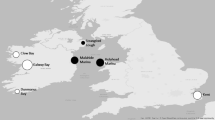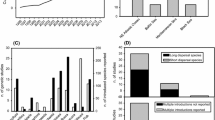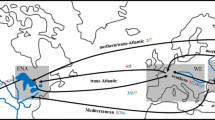Abstract
Despite a well-developed theoretical basis for the role of genetic diversity in the colonization process, contemporary investigations of genetic diversity in biological invasions have downplayed its importance. Observed reductions in genetic diversity have been argued to have a limited effect on the success of establishment and impact based on empirical studies; however, those studies rarely include assessment of failed or comparatively less-successful biological invasions. We address this gap by comparing genetic diversity at microsatellite loci for taxonomically and geographically paired aquatic invasive species. Our four species pairs contain one highly successful and one less-successful invasive species (Gobies: Neogobius melanostomus, Proterorhinus semilunaris; waterfleas: Bythotrephes longimanus, Cercopagis pengoi; oysters: Crassostrea gigas, Crassostrea virginica; tunicates: Bortylloides violaceous, Botryllus schlosseri). We genotyped 2717 individuals across all species from multiple locations in multiple years and explicitly test whether genetic diversity is lower for less-successful biological invaders within each species pair. We demonstrate that, for gobies and tunicates, reduced allelic diversity is associated with lower success of invasion. We also found that less-successful invasive species tend to have greater divergence among populations. This suggests that intraspecific hybridization may be acting to convert among-population variation to within-population variation for highly successful invasive species and buffering any loss of diversity. While our findings highlight the species-specific nature of the effects of genetic diversity on invasion success, they do support the use of genetic diversity information in the management of current species invasions and in the risk assessment of potential future invaders.


Similar content being viewed by others
References
Baker H, Stebbins G (eds) (1965) The genetics of colonizing species. Academic Press, New York
Barrett SCH (2015) Foundations of invasion genetics: the Baker and Stebbins legacy. Mol Ecol 24:1927–1941. doi:10.1111/mec.13014
Bates D, Mächler M, Bolker B, Walker S (2015) Fitting linear mixed-effects models using lme4. J Stat Softw 67:1–48. doi:10.18637/jss.v067.i01
Benjamini Y, Hochberg Y (1995) Controlling the false discovery rate: a practical and powerful approach to multiple testing. J R Stat Soc B 57:289–300
Blackburn TM, Lockwood JL, Cassey P (2015) The influence of numbers on invasion success. Mol Ecol 24:1942–1953. doi:10.1111/mec.13075
Bock DG, Caseys C, Cousens RD et al (2015) What we still don’t know about invasion genetics. Mol Ecol 24:2277–2297. doi:10.1111/mec.13032
Brown JE, Stepien CA (2009) Invasion genetics of the Eurasian round goby in North America: tracing sources and spread patterns. Mol Ecol 18:64–79. doi:10.1111/j.1365-294X.2008.04014.x
Brown JE, Stepien CA (2010) Population genetic history of the dreissenid mussel invasions: expansion patterns across North America. Biol Invasions 12:3687–3710. doi:10.1007/s10530-010-9763-2
Calabrese A, Davis HC (1970) Tolerances and requirements of embryos and larvae of bivalve molluscs. Helgoländer Meeresun 20:553–564. doi:10.1007/BF01609928
Carlton JT (1992) Introduced marine and estuarine mollusks of North America: an end-of-the-20th-century perspective. J Shellfish Res 11:489–505
Carver C, Mallet A, Vercaemer B (2006) Biological synopsis of the colonial tunicates (Botryllus schlosseri and Botrylloides violaceus). Can Man Rep Fish Aquat Sci 2747:42
Cavaletto JF, Vanderploeg HA, Pichlová-PtáČníková R et al (2010) Temporal and spatial separation allow coexistence of predatory cladocerans: Leptodora kindtii, Bythotrephes longimanus and Cercopagis pengoi, in southeastern Lake Michigan. J Gt Lakes Res 36:65–73. doi:10.1016/j.jglr.2010.04.006
Charlesworth D, Charlesworth B (1987) Inbreeding depression and its evolutionary consequences. Annu Rev Ecol Syst 18:237–268. doi:10.1146/annurev.ecolsys.18.1.237
Colautti RI, Lau JA (2015) Contemporary evolution during invasion: evidence for differentiation, natural selection, and local adaptation. Mol Ecol 24:1999–2017. doi:10.1111/mec.13162
Colautti RI, MacIsaac HJ (2004) A neutral terminology to define “invasive” species. Divers Distrib 10:135–141. doi:10.1111/j.1366-9516.2004.00061.x
Colautti RI, Manca M, Viljanen M et al (2005) Invasion genetics of the Eurasian spiny waterflea: evidence for bottlenecks and gene flow using microsatellites. Mol Ecol 14:1869–1879. doi:10.1111/j.1365-294X.2005.02565.x
Colosimo PF, Peichel CL, Nereng K et al (2004) The genetic architecture of parallel armor plate reduction in threespine sticklebacks. PLoS Biol 2:635–641. doi:10.1371/journal.pbio.0020109
De Wit P, Pespeni MH, Ladner JT et al (2012) The simple fool’s guide to population genomics via RNA-Seq: an introduction to high-throughput sequencing data analysis. Mol Ecol Resour 12:1058–1067. doi:10.1111/1755-0998.12003
Dijkstra J, Harris LG, Westerman E (2007) Distribution and long-term temporal patterns of four invasive colonial ascidians in the Gulf of Maine. J Exp Mar Bio Ecol 342:61–68. doi:10.1016/j.jembe.2006.10.015
Dlugosch KM, Parker I (2008) Founding events in species invasions: genetic variation, adaptive evolution, and the role of multiple introductions. Mol Ecol 17:431–449. doi:10.1111/j.1365-294X.2007.03538.x
Dlugosch KM, Anderson SR, Braasch J et al (2015) The devil is in the details: genetic variation in introduced populations and its contributions to invasion. Mol Ecol 24:2095–2111. doi:10.1111/mec.13183
Do C, Waples RS, Peel D et al (2014) NeEstimator v2: re-implementation of software for the estimation of contemporary effective population size (Ne) from genetic data. Mol Ecol Resour 14:209–214. doi:10.1111/1755-0998.12157
Ellegren H (2014) Genome sequencing and population genomics in non-model organisms. Trends Ecol Evol 29:51–63. doi:10.1016/j.tree.2013.09.008
Elphinstone MS, Hinten GN, Anderson MJ, Nock CJ (2003) An inexpensive and high-throughput procedure to extract and purify total genomic DNA for population studies. Mol Ecol Notes 3:317–320. doi:10.1046/j.1471-8286.2003.00397.x
Fisher R (1930) The genetical theory of natural selection. Clarendon Press, Oxford
Gillespie G (2007) Distribution of non-indigenous intertidal species on the Pacific Coast of Canada. Nippon Suisan Gakkaishi 73:1133–1137. doi:10.2331/suisan.73.1133
Goudet J, Jombart T (2015) hierfstat: estimation and tests of hierarchical F-statistics. R package version 0.04-22. https://CRAN.R-project.org/package=hierfstat
Grant KA, Shadle MJ, Andraso G (2012) First report of tubenose goby (Proterorhinus semilunaris) in the eastern basin of Lake Erie. J Gt Lakes Res 38:821–824. doi:10.1016/j.jglr.2012.09.019
He X, Johansson ML, Heath DD (2016) Role of genomics and transcriptomics in selection of reintroduction source populations. Conserv Biol 30:1010–1018. doi:10.1111/cobi.12674
Johannsson OE, Mills EL, O’Gorman R (1991) Changes in the nearshore and offshore zooplankton communities in Lake Ontario: 1981–88. Can J Fish Aquat Sci 48:1546–1557. doi:10.1139/f91-183
Jombart T (2008) Adegenet: a R package for the multivariate analysis of genetic markers. Bioinformatics 24:1403–1405. doi:10.1093/bioinformatics/btn129
Jombart T, Devillard S, Balloux F et al (2010) Discriminant analysis of principal components: a new method for the analysis of genetically structured populations. BMC Genet 11:94. doi:10.1186/1471-2156-11-94
Jude DJ, Reider RH, Smith GR (1992) Establishment of Gobiidae in the Great Lakes basin. Can J Fish Aquat Sci 49:416–421
Kinziger AP, Nakamoto RJ, Anderson EC, Harvey BC (2011) Small founding number and low genetic diversity in an introduced species exhibiting limited invasion success (speckled dace, Rhinichthys osculus). Ecol Evol 1:73–84. doi:10.1002/ece3.8
Kocovsky PM, Tallman JA, Jude DJ et al (2011) Expansion of tubenose gobies Proterorhinus semilunaris into western Lake Erie and potential effects on native species. Biol Invasions 13:2775–2784. doi:10.1007/s10530-011-9962-5
Kolbe JJ, Glor RE, Rodríguez Schettino L et al (2004) Genetic variation increases during biological invasion by a Cuban lizard. Nature 431:177–181. doi:10.1038/nature02807
Kolbe JJ, Leal M, Schoener TW et al (2012) Founder effects persist despite adaptive differentiation: a field experiment with lizards. Science 335:1086–1089. doi:10.1126/science.1209566
Lenihan HS (1999) Physical-biological coupling on oyster reefs: how habitat structure influences individual performance. Ecol Monogr 69:251–275. doi:10.1890/0012-9615(1999)069[0251:PBCOOR]2.0.CO;2
Lockwood JL, Cassey P, Blackburn T (2005) The role of propagule pressure in explaining species invasions. Trends Ecol Evol 20:223–228. doi:10.1016/j.tree.2005.02.004
MacIsaac HJ, Grigorovich IA, Hoyle JA et al (1999) Invasion of Lake Ontario by the Ponto-Caspian predatory cladoceran Cercopagis pengoi. Can J Fish Aquat Sci 56:1–5. doi:10.1139/cjfas-56-1-1
Nei M, Maruyama T, Chakraborty R (1975) The bottleneck effect and genetic variability in populations. Evolution 29:1–10
Paetkau D, Slade R, Burden M, Estoup A (2004) Genetic assignment methods for the direct, real-time estimation of migration rate: a simulation-based exploration of accuracy and power. Mol Ecol 13:55–65. doi:10.1046/j.1365-294X.2003.02008.x
Paradis E (2010) pegas: an R package for population genetics with an integrated-modular approach. Bioinformatics 26:419–420
Pettitt-Wade H (2016) Niche breadth and invasion success. Ph.D. dissertation, Great Lakes Institute for Environmental Research, University of Windsor, Windsor, Ontario, Canada
Pettitt-Wade H, Wellband KW, Heath DD, Fisk AT (2015) Niche plasticity in invasive fishes in the Great Lakes. Biol Invasions 17:2565–2580. doi:10.1007/s10530-015-0894-3
Ptáčniková R, Vanderploeg HA, Cavaletto JF (2015) Big versus small: does Bythotrephes longimanus predation regulate spatial distribution of another invasive predatory cladoceran, Cercopagis pengoi? J Great Lakes Res 41:143–149. doi:10.1016/j.jglr.2015.10.006
R Core Team (2016) R: a language and environment for statistical computing. R Foundation for Statistical Computing, Vienna, Austria. https://www.R-project.org/
Rannala B, Mountain JL (1997) Detecting immigration by using multilocus genotypes. Proc Natl Acad Sci USA 94:9197–9201
Rouger R, Reichel K, Malrieu F et al (2016) Effects of complex life cycles on genetic diversity: cyclical parthenogenesis. Heredity 117:336–347. doi:10.1038/hdy.2016.52
Ruesink JL, Lenihan HS, Trimble AC et al (2005) Introduction of non-native oysters: ecosystem effects and restoration implications. Annu Rev Ecol Evol Syst 36:643–689. doi:10.1146/annurev.ecolsys.36.102003.152638
Sakai AK, Allendorf FW, Holt JS et al (2001) The population biology of invasive species. Annu Rev Ecol Syst 32:305–332
Signorile AL, Wang J, Lurz PWW et al (2014) Do founder size, genetic diversity and structure influence rates of expansion of North American grey squirrels in Europe? Divers Distrib 20:918–930. doi:10.1111/ddi.12222
Stepien CA, Tumeo MA (2006) Invasion genetics of Ponto-Caspian gobies in the Great Lakes: a “cryptic” species, absence of founder effects, and comparative risk analysis. Biol Invasions 8:61–78. doi:10.1007/s10530-005-0237-x
Therriault TW, Grigorovich IA, Kane DD et al (2002) Range expansion of the exotic zooplankter Cercopagis pengoi (Ostroumov) into western Lake Erie and Muskegon Lake. J Gt Lakes Res 28:698–701. doi:10.1016/S0380-1330(02)70615-1
Uller T, Leimu R (2011) Founder events predict changes in genetic diversity during human-mediated range expansions. Glob Chang Biol 17:3478–3485. doi:10.1111/j.1365-2486.2011.02509.x
Waples R, Do C (2008) LDNE: a program for estimating effective population size from data on linkage disequilibrium. Mol Ecol Resour 8:753–756. doi:10.1111/j.1755-0998.2007.02061.x
Weir BS, Cockerham CC (1984) Estimating F-statistics for the analysis of population structure. Evolution 38:1358–1370. doi:10.2307/2408641
Yan ND, Leung B, Lewis MA, Peacor SD (2011) The spread, establishment and impacts of the spiny water flea, Bythotrephes longimanus, in temperate North America: a synopsis of the special issue. Biol Invasions 13:2423–2432. doi:10.1007/s10530-011-0069-9
Zenni RD, Nuñez MA (2013) The elephant in the room: the role of failed invasions in understanding invasion biology. Oikos 122:801–815. doi:10.1111/j.1600-0706.2012.00254.x
Acknowledgements
We are greatly indebted to Dr. Tom Therriault and Dr. Chris McKindsey and their respective Department of Fisheries and Oceans Canada sampling teams who collected the oysters and tunicates used in this study. We would also like to thank Colin Van Overdijk for his assistance collecting the waterfleas and Katerina Stojanovich and Kelly McLean for their assistance collecting gobies. This work was supported by funds from the Canadian Aquatic Invasive Species Network II grant (NSERC) to ATF and DDH. HPW received support from an Ontario Trillium Scholarship and KWW received support from NSERC.
Author information
Authors and Affiliations
Corresponding author
Electronic supplementary material
Below is the link to the electronic supplementary material.
Rights and permissions
About this article
Cite this article
Wellband, K.W., Pettitt-Wade, H., Fisk, A.T. et al. Differential invasion success in aquatic invasive species: the role of within- and among-population genetic diversity. Biol Invasions 19, 2609–2621 (2017). https://doi.org/10.1007/s10530-017-1471-8
Received:
Accepted:
Published:
Issue Date:
DOI: https://doi.org/10.1007/s10530-017-1471-8




